编制机构:雅昌艺术市场监测中心(AMMA)
艺术雷达站/供稿
“金牛祥云”与国际著名的公共艺术作品进行更为深入的类比分析,以此探讨这些作品在设计理念、材料运用、环境互动和文化象征等方面的共性与个性。
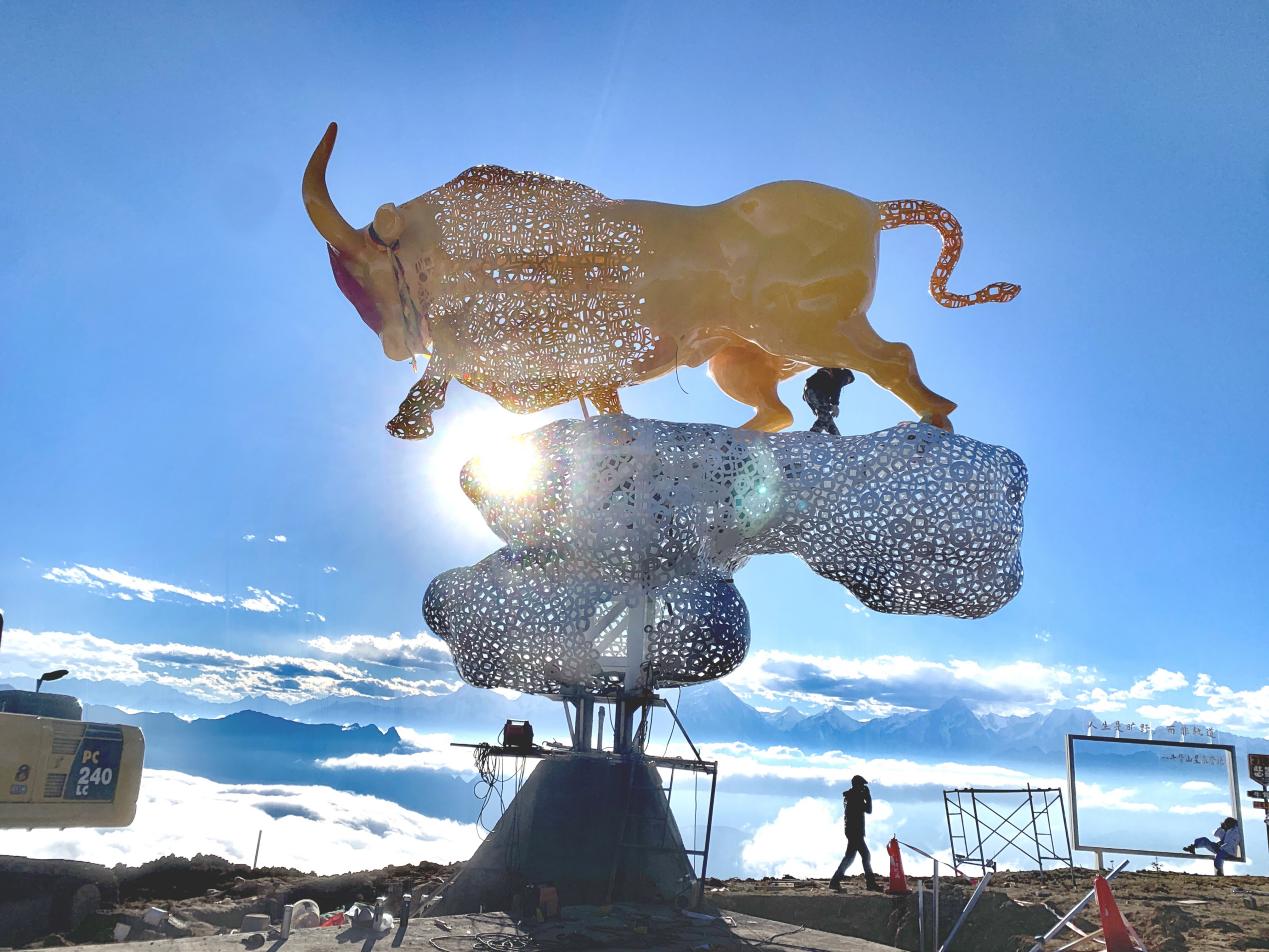
1. 芝加哥“云门”(The Bean)——反射与空间互动的现代性
作品介绍: 芝加哥的“云门”(Cloud Gate),又称“豆子”,由印度裔英国艺术家阿尼什·卡普尔(Anish Kapoor)设计。这个巨型雕塑由168块不锈钢板组成,表面光滑如镜,倒映着周围的建筑、天空和观众的身影,创造了一种无限的空间感和互动性。
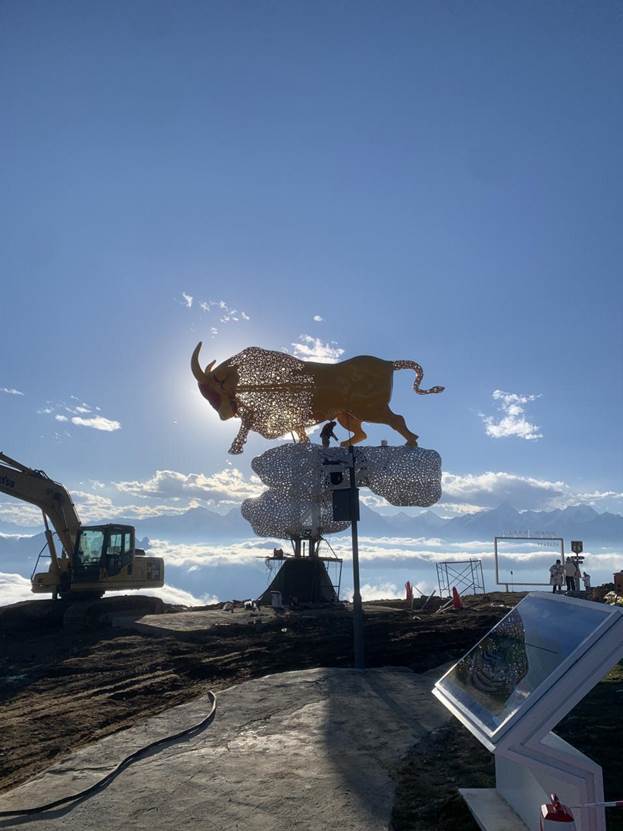
类比分析: “云门”以其镜面效果闻名,通过反射环境和观众本身,让人们在观看艺术的同时,也被作品“观看”并参与到艺术之中。这种互动性使得作品不仅仅是一件雕塑,而成为城市生活的参与者,与空间和人流形成对话。而“金牛祥云”则以其镂空和光影效果在视觉上创造了动态变化,使观众在不同时间和角度中产生不同的观赏体验。这两件作品都强调了与观众的互动性,“云门”通过镜面反射,而“金牛祥云”则通过镂空结构与灯光营造光影互动,赋予作品不同的生命力。
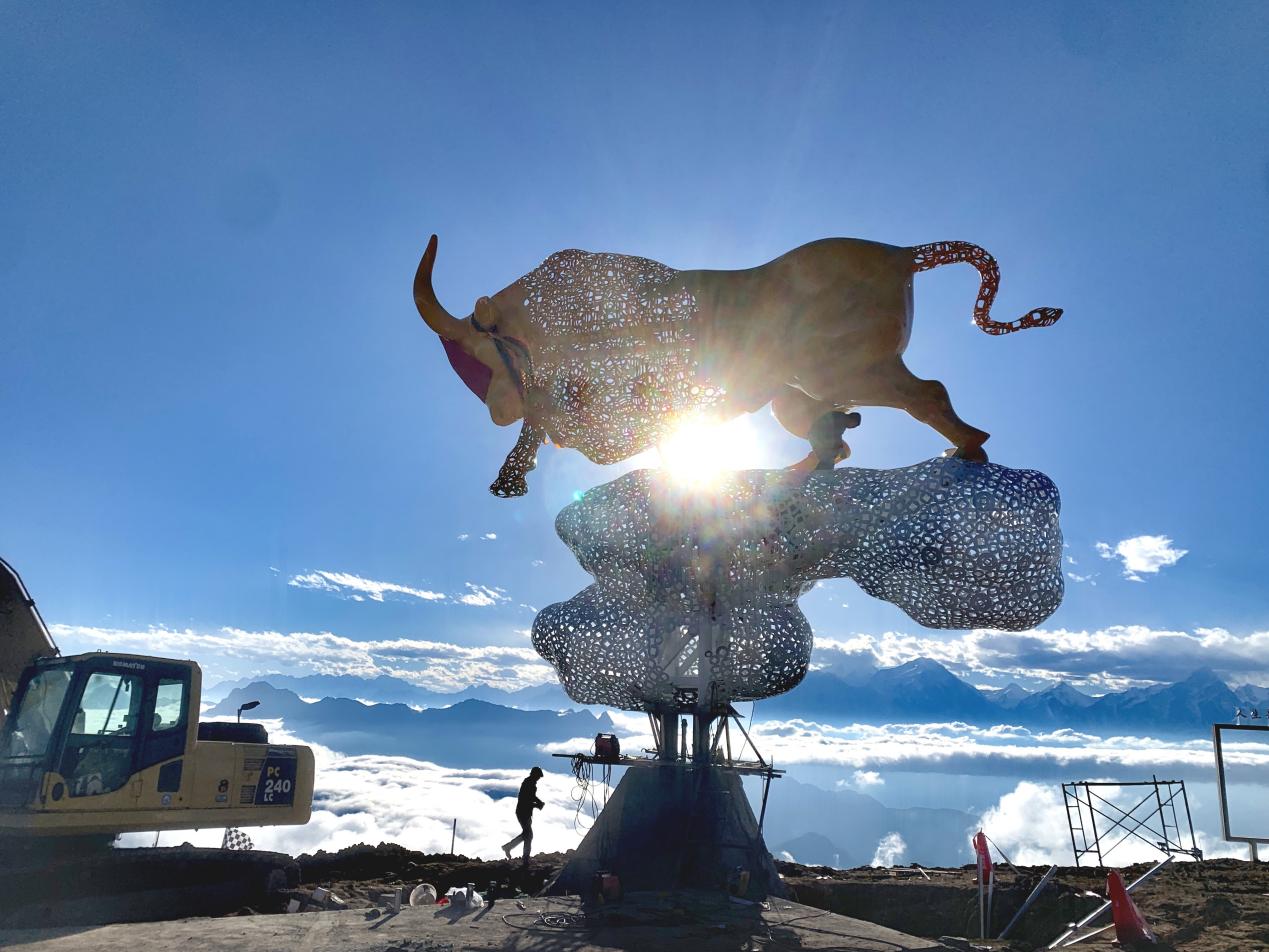
2. 巴黎“夏尔·马尔蒂诺音波”雕塑——声音与光影的联动
作品介绍: 法国巴黎的“音波”(Waves of Charles Martel)雕塑由艺术家夏尔·马尔蒂诺(Charles Martel)创作,利用声波和光影的结合,创造了一种跨感官的观赏体验。这件雕塑不仅仅是视觉装置,观众可以通过声音感知作品的不同氛围。

类比分析: “音波”雕塑通过声音和光影的互动让人们在物理空间中体验时间的流动和感官的交互。“金牛祥云”虽然没有声音设计,但在视觉效果上实现了光影的变化,尤其在夜晚的灯光环境下,它宛如浮云上的金牛,呈现出神秘的力量感。二者在不同媒介中都强调了互动性和感官体验,将公共艺术作品从静态的观赏物变成具有动态体验的存在。这种设计思路都提升了作品的沉浸感,让观众更主动地参与其中。
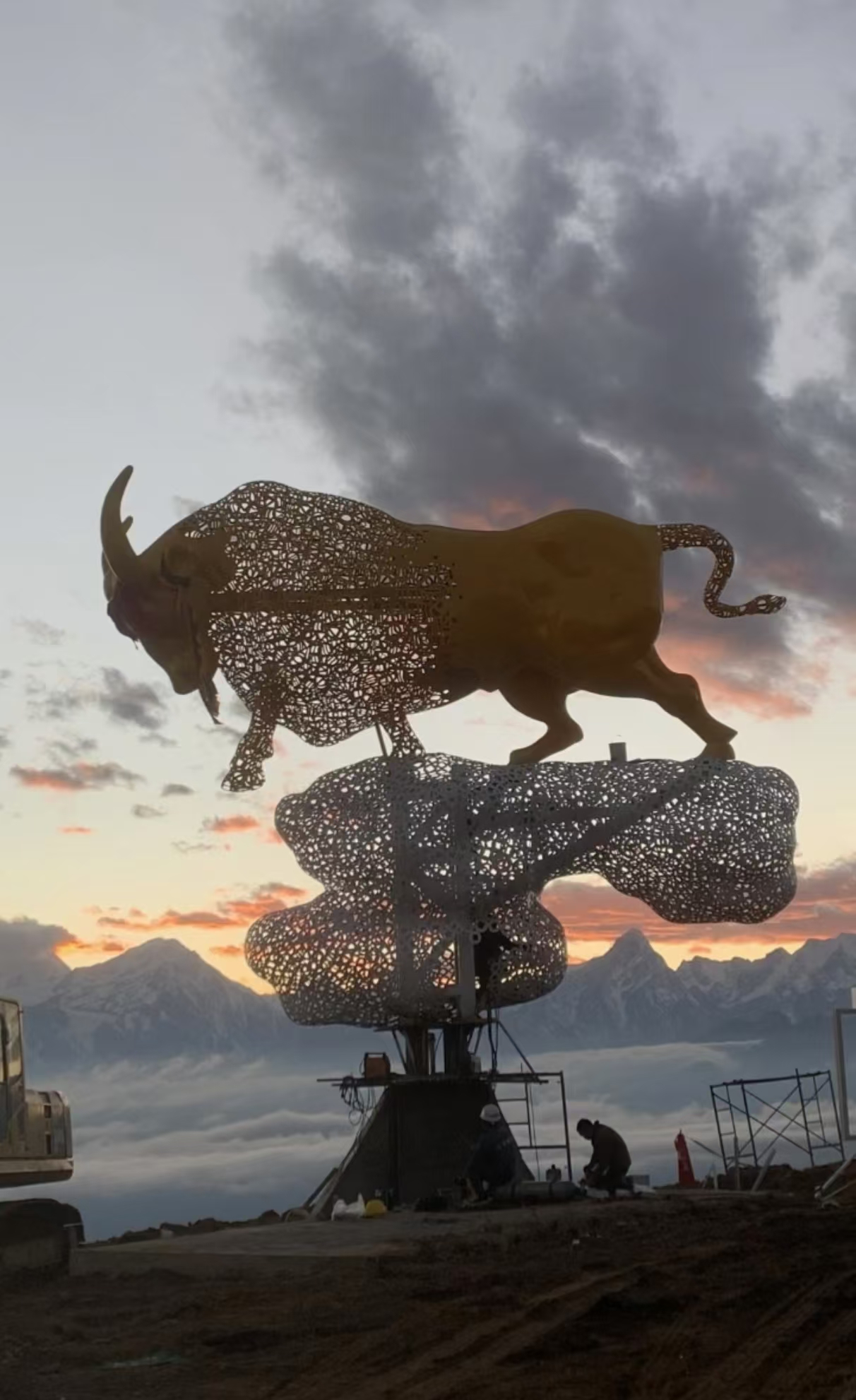
3. 西班牙毕尔巴鄂古根海姆博物馆前的“蜘蛛”(Maman)——母性与生命的象征
作品介绍: “蜘蛛”(Maman)是著名艺术家路易丝·布尔乔亚(Louise Bourgeois)创作的巨型雕塑,屹立在西班牙毕尔巴鄂古根海姆博物馆前。它以巨大的金属蜘蛛形象,象征着母性和生命的延续,给观众一种既亲切又诡异的情感体验。
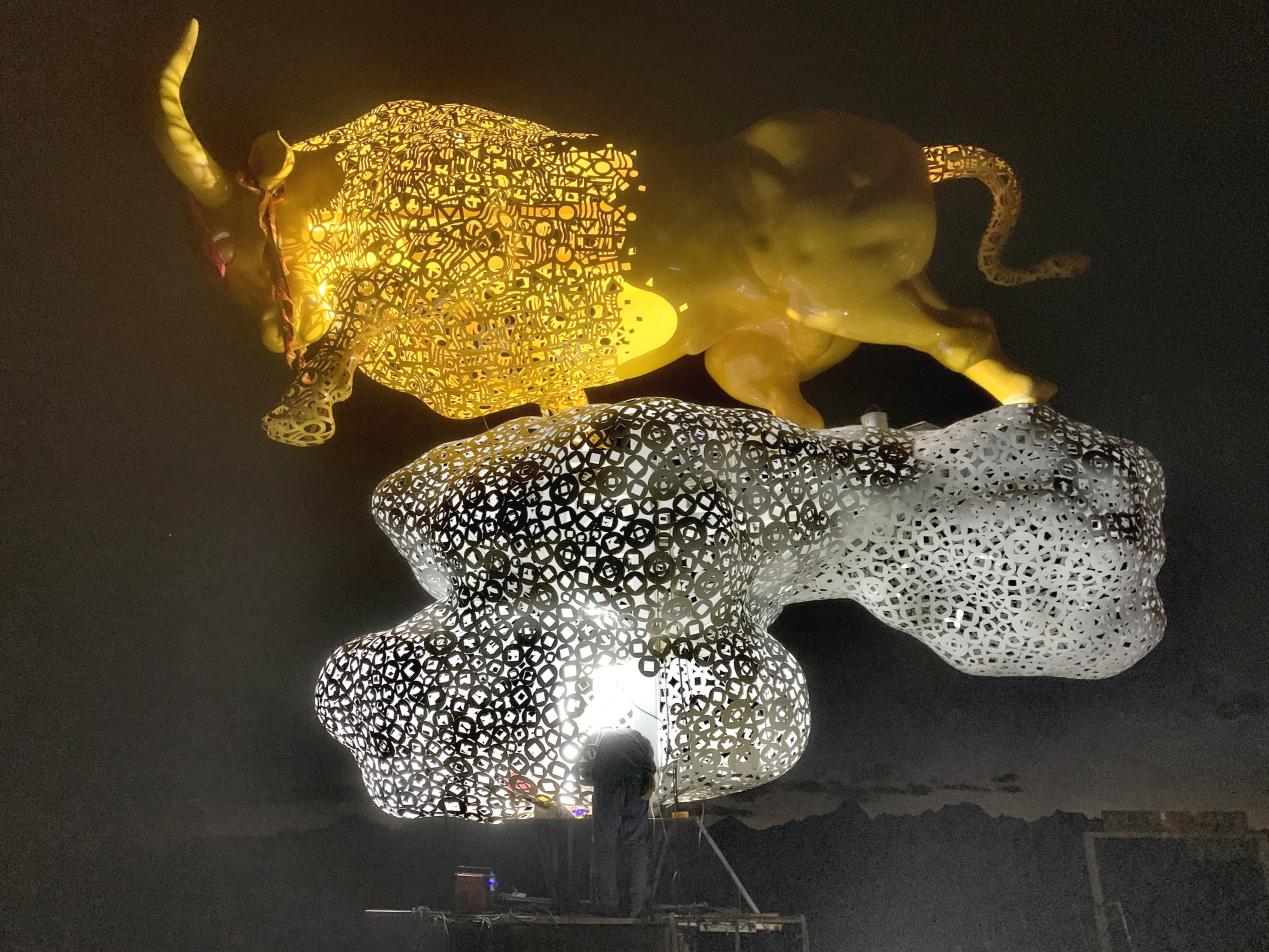
类比分析: “蜘蛛”是一种强烈的视觉冲击,它的巨大体量让人既感到压迫,又被其造型吸引。这种形式带有母性的温柔和保护,但也暗含着不安和脆弱的感受。“金牛祥云”同样采用了体量庞大的金属结构,其造型蕴含着力量、稳重与祥和的意象,传达了中国文化中对财富和稳定的期盼。二者的共同点在于通过超现实的巨型动物形象打破人们对传统雕塑的认知,并且利用材质的质感和环境的配合,营造出一种引人深思的氛围。

4. 日本濑户内海的“南瓜”雕塑(Pumpkin)——地域文化与自然环境的结合
作品介绍: 日本艺术家草间弥生创作的“南瓜”雕塑位于濑户内海的直岛上。黄色的南瓜雕塑上布满了黑色圆点,摆放在海岸边,象征着生命的循环和丰收,成为直岛艺术之旅的重要地标。
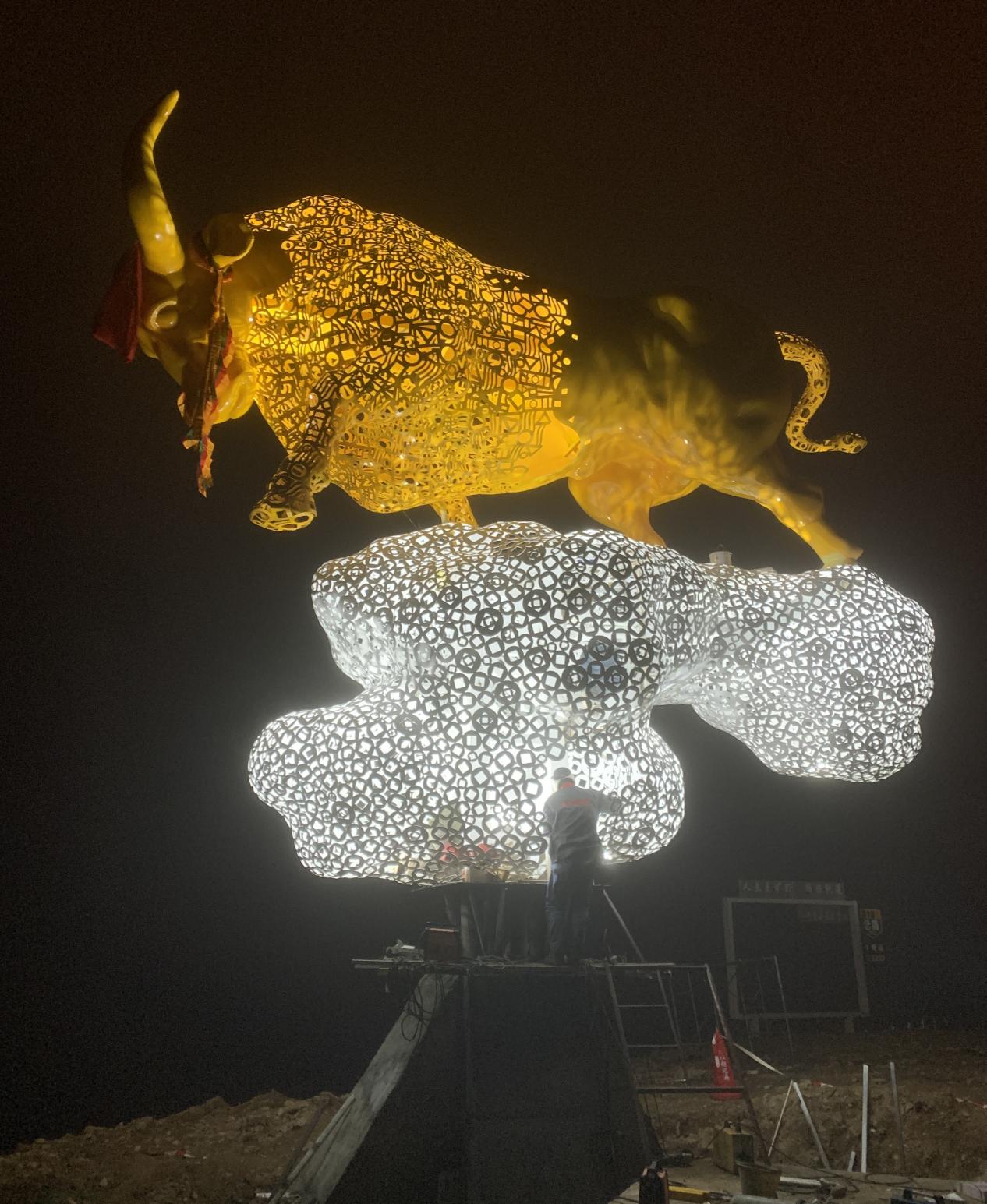
类比分析: “南瓜”雕塑的设计意图是将艺术融入自然环境中,与大海和岛屿风光融为一体。这一作品因其独特的色彩和造型,吸引了无数游客的目光,并赋予当地文化一种独特的符号象征。“金牛祥云”同样通过其地理位置和雕塑形象将自然环境与艺术结合,使雕塑在广袤的山川背景下更显生动。这两件作品都通过独特的造型和环境的融合,强调了地域特色,并通过视觉冲击力吸引观众驻足,让艺术成为风景的一部分,且使之在不同光线条件下呈现出多样化的美感。

5. 英国伦敦的“极光桥”(The Light Bridge)——灯光与结构的动态交互
作品介绍: 伦敦的“极光桥”是一座结合了现代光影技术的桥梁艺术作品,设计者在桥上安装了动态光源,让整座桥梁在夜晚宛如极光一般闪烁,吸引了大量市民和游客前来观赏。

类比分析: “极光桥”利用灯光的动态效果,在夜晚制造出一种梦幻的视觉感受。傅榆翔的“金牛祥云”也通过灯光在夜晚展现出与白天完全不同的效果,这种光影变化赋予了雕塑一种不同时段的生动性和活力。二者都通过现代科技手段让作品与环境进行深度互动,尤其是“金牛祥云”在镂空结构上的灯光设计,使得雕塑在夜晚宛如漂浮在空中的云彩和金牛,达到了极具戏剧性的视觉效果,成为夜间景观中的亮点。
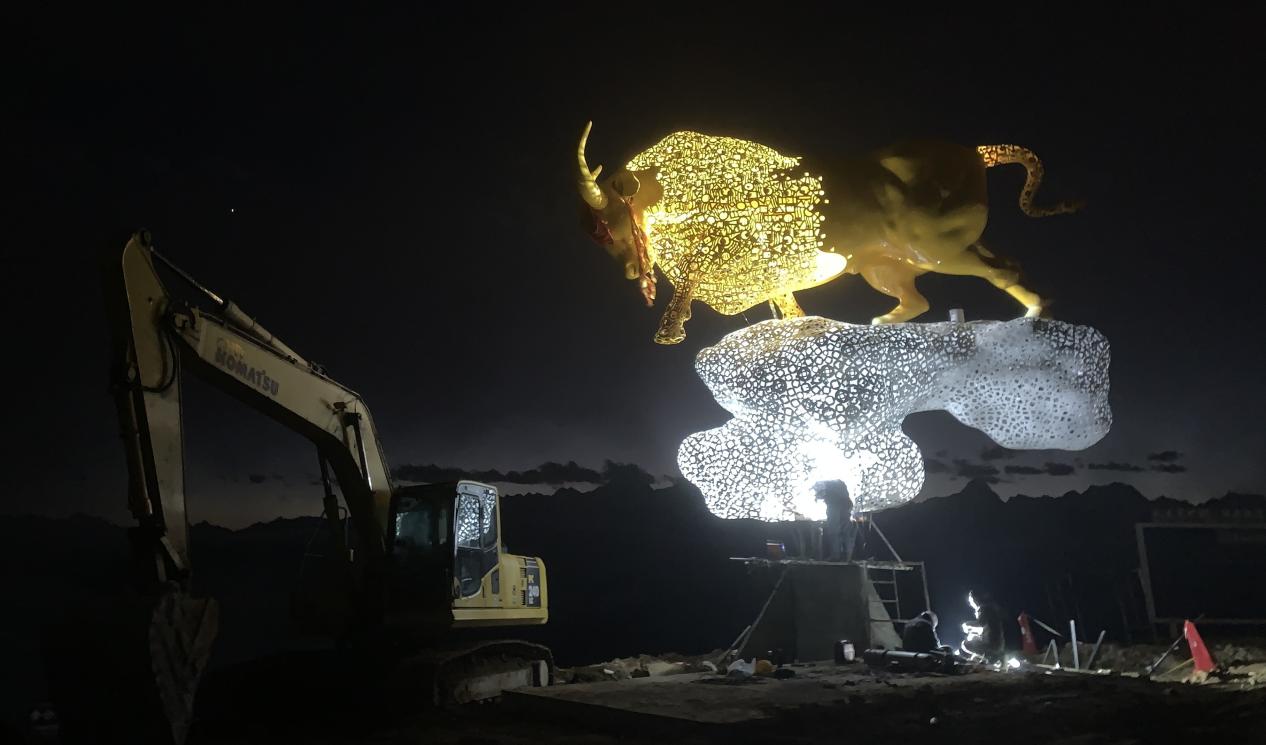
总结对比与评价:
这些国际著名的公共艺术作品与“金牛祥云”有着不少共通点,都体现了艺术与环境的深度融合、材料与技术的创新运用以及对观众的互动体验。这些作品的共同点包括以下几个方面:

互动性与沉浸感:这些作品都通过视觉或多感官的手法让观众主动参与到作品的体验中,“云门”的镜面、“音波”的声音、“极光桥”的动态灯光效果等都让人身临其境;而“金牛祥云”则通过镂空和灯光效果实现了与光影的互动,观众在白天与夜晚欣赏到的效果迥然不同,增强了作品的沉浸感。
材料与环境的关系:不论是草间弥生的“南瓜”与濑户内海的岛屿、还是“蜘蛛”与古根海姆博物馆的城市景观,这些作品的材质和造型都与其所处的环境相得益彰,成为环境的一部分。而“金牛祥云”放置在山川环绕之中,其镂空云层结构与山间云雾相互呼应,达到了艺术与自然的高度融合。
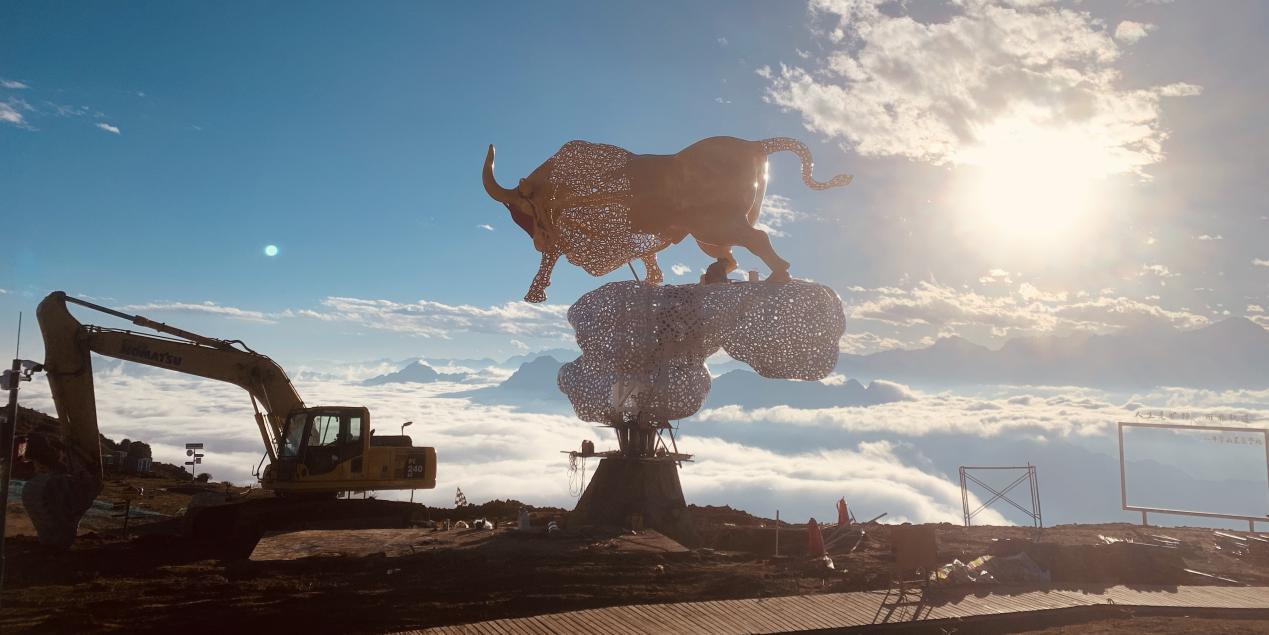
文化与象征意义:这些作品不仅在视觉上令人印象深刻,也在文化内涵上有所表达。例如,“蜘蛛”象征母性,“南瓜”代表丰收与自然循环,“云门”隐喻着城市的包容和多样性;同样,“金牛祥云”也蕴含了中国传统文化中的祥瑞寓意,传达了勤劳、力量、财富和福祉的象征意义。
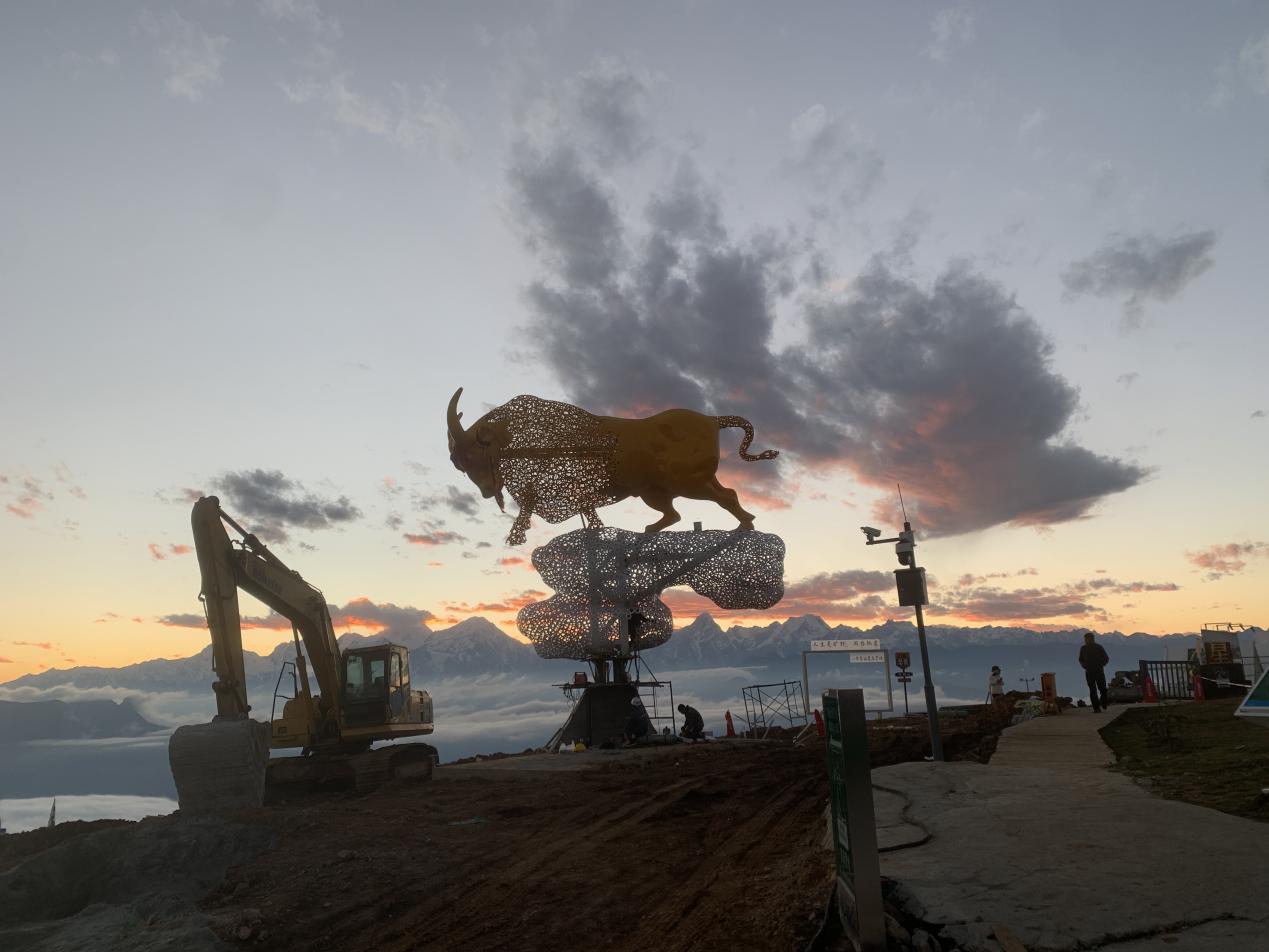
现代科技的应用:这些作品或多或少都使用了现代科技来增强其艺术效果,例如“极光桥”的动态光源技术、“金牛祥云”的镂空灯光设计等都显示了艺术家在技术上的创新。这种手法让艺术作品不再仅仅是静态的观赏对象,而是具有动态表现力的装置。
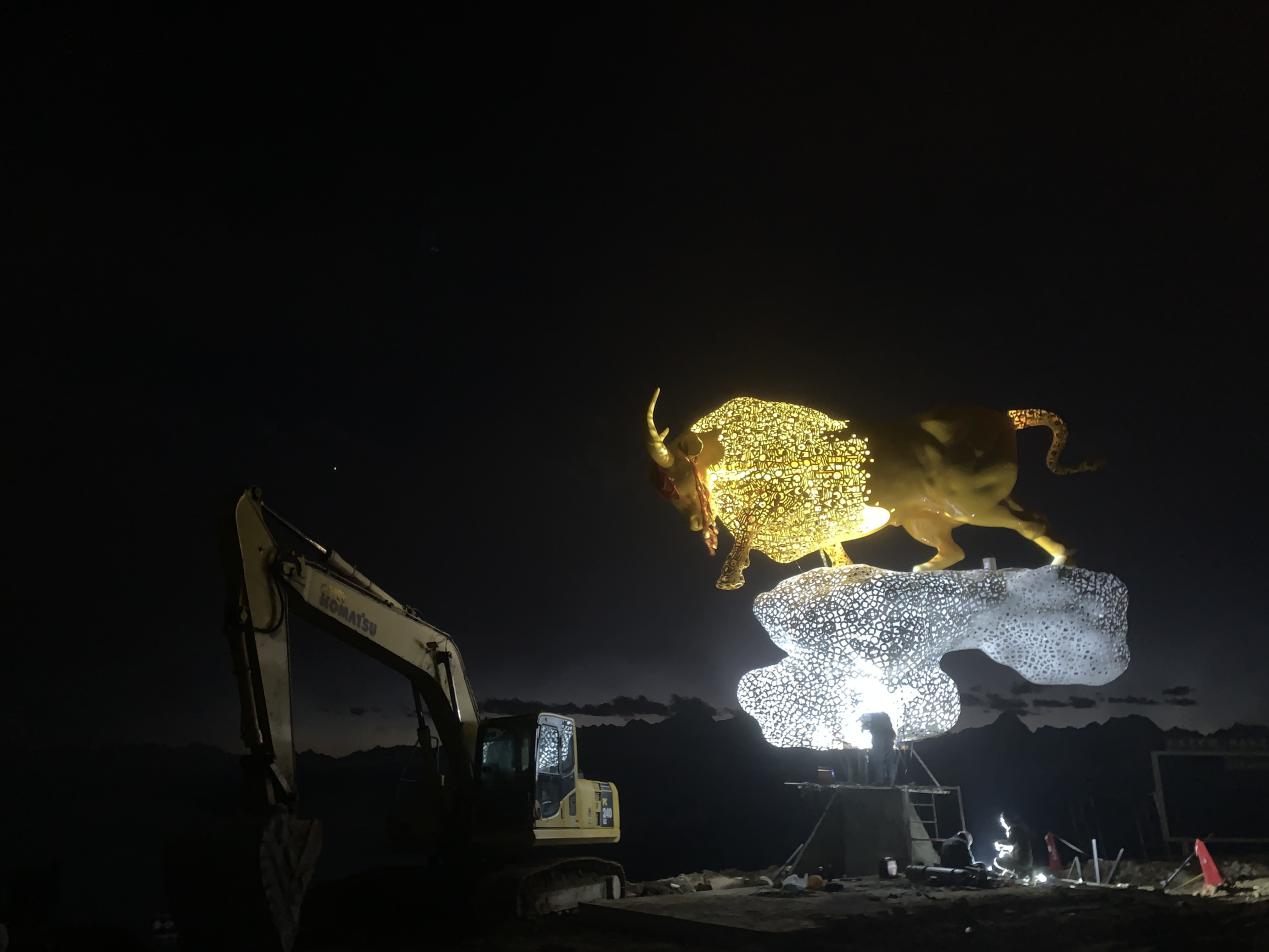
综上所述,傅榆翔的“金牛祥云”在借鉴国际公共艺术设计手法的同时,结合了本土文化的符号,将传统意象通过现代材料和光影技术进行呈现,是一次极具探索性的尝试。它不仅可以与世界公共艺术作品媲美,还通过浓厚的文化内涵与中国本土元素的结合,塑造了独一无二的视觉与精神体验,为中国的公共艺术发展提供了新方向。
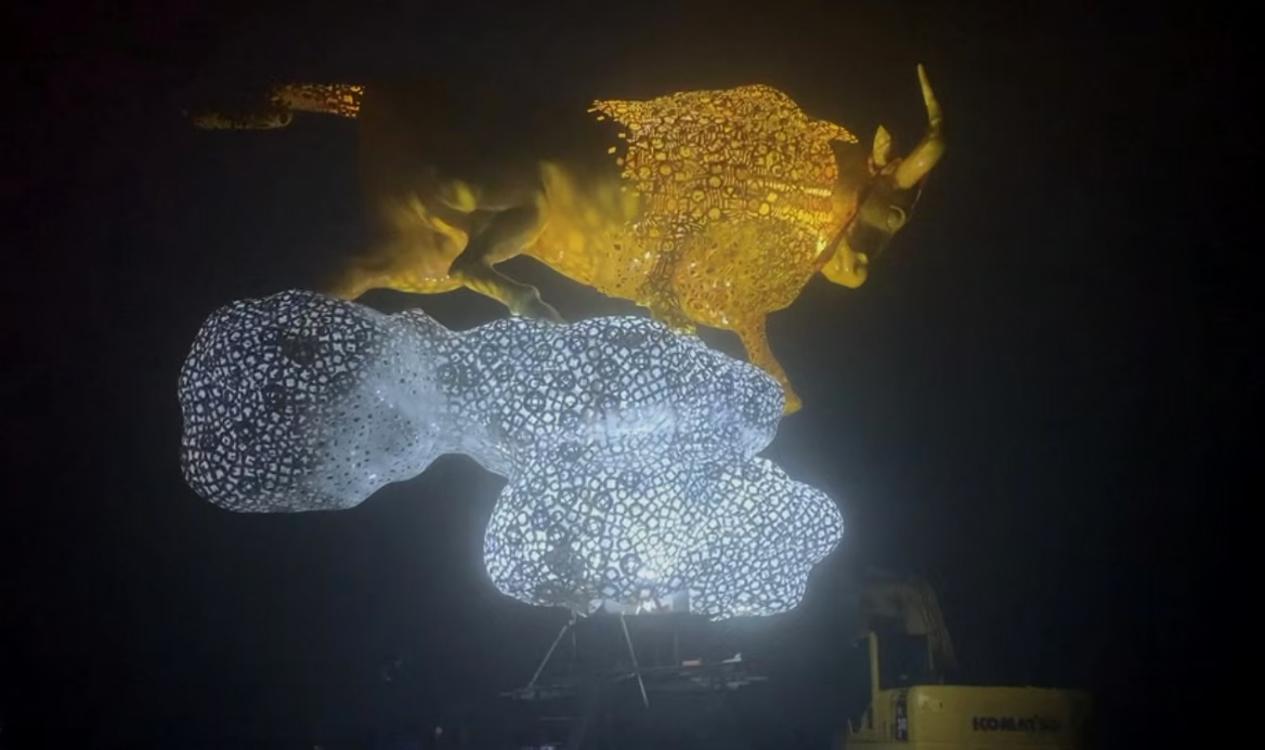
The Cultural Resonance in the Interplay of Light and Shadow: The Dialogue between Golden Bull and Auspicious Clouds and World Public Art
Art Radar Station / Contributed
By comparing “Golden Bull and Auspicious Clouds” with internationally renowned public art pieces, this article explores the commonalities and unique qualities in terms of design philosophy, material usage, environmental interaction, and cultural symbolism.
1. Chicago’s Cloud Gate ("The Bean") — Modernity in Reflection and Spatial Interaction
Artwork Introduction: Chicago's "Cloud Gate," also known as "The Bean," was created by British-Indian artist Anish Kapoor. This massive sculpture comprises 168 stainless steel plates, polished to a mirror-like finish that reflects the surrounding buildings, sky, and people, creating an infinite spatial sense and interactivity.
Comparative Analysis: Known for its mirror effect, "Cloud Gate" invites viewers to engage with the piece while simultaneously being "seen" by it, blurring the line between art and spectator. This interaction makes the sculpture a participant in city life, engaging in dialogue with both space and crowds. In a similar way, "Golden Bull and Auspicious Clouds" creates dynamic visual shifts through its hollowed and light-infused design, offering viewers a new experience from different angles and times of day. While "Cloud Gate" achieves interactivity through reflective surfaces, "Golden Bull and Auspicious Clouds" accomplishes this through light and shadow, endowing the piece with a lively essence.
2. Paris’ Sound Wave Sculpture by Charles Martel — The Convergence of Sound and Shadow
Artwork Introduction: "Waves of Charles Martel" in Paris, created by artist Charles Martel, combines sound waves and light to provide a multi-sensory experience. Viewers experience this sculpture not just visually but also through sound.
Comparative Analysis: The "Waves" sculpture allows audiences to sense the flow of time and cross-sensory interaction in physical space through sound and light. Although "Golden Bull and Auspicious Clouds" lacks sound, it utilizes lighting to produce a mysterious effect, especially at night, when it appears like a bull floating on clouds. Both works emphasize interactivity and sensory immersion, transforming public art from a static object into a dynamic experience, encouraging viewers to engage actively.
3. "Maman" in front of Bilbao’s Guggenheim Museum — A Symbol of Motherhood and Life
Artwork Introduction: “Maman,” the iconic spider sculpture by artist Louise Bourgeois, stands outside the Guggenheim Museum in Bilbao, Spain. Representing motherhood and the continuation of life, this massive metal spider evokes emotions that are both comforting and unsettling.
Comparative Analysis: "Maman" delivers a powerful visual impact with its sheer scale, eliciting a sense of both awe and fascination. It conveys maternal tenderness and protection while hinting at vulnerability. "Golden Bull and Auspicious Clouds" similarly employs a large-scale metal structure, embodying strength, stability, and harmony—a cultural symbol of prosperity and stability in China. Both sculptures use an enlarged animal form to challenge traditional perceptions of sculpture, engaging viewers in a contemplative experience.
4. Japan’s Pumpkin Sculpture on Naoshima — Integration of Regional Culture and Natural Surroundings
Artwork Introduction: Japanese artist Yayoi Kusama’s “Pumpkin” sculpture on Naoshima Island in the Seto Inland Sea is covered in black polka dots, symbolizing the cycles of life and harvest. It has become an essential landmark of the Naoshima art experience.
Comparative Analysis: The pumpkin sculpture merges with the natural environment, blending seamlessly with the surrounding sea and island landscape. Its unique colors and shapes attract numerous visitors, giving local culture a distinctive symbol. Similarly, "Golden Bull and Auspicious Clouds" integrates art with nature through its geographical placement, making it stand out against a backdrop of mountains. Both pieces emphasize regional characteristics through unique designs that blend with their surroundings, inviting audiences to engage deeply.
5. London’s The Light Bridge — Dynamic Interaction of Light and Structure
Artwork Introduction: London’s "The Light Bridge" is an architectural art piece that uses modern light technology to create a mesmerizing, aurora-like glow in the evenings, attracting locals and tourists alike.
Comparative Analysis: The Light Bridge’s dynamic lighting creates a dreamlike visual at night. Similarly, "Golden Bull and Auspicious Clouds" reveals an entirely different effect at night, with lighting enhancing its hollow design to resemble clouds and a golden bull floating in midair. Both pieces use modern technology to deeply interact with their environment, adding vibrancy to the nightscape and establishing a focal point for the nighttime atmosphere.
Summary of Comparison and Evaluation:
These internationally renowned public artworks and "Golden Bull and Auspicious Clouds" share several key elements, reflecting deep integration with the environment, innovative material and technological applications, and audience interactivity. Here are some shared characteristics:
Interactivity and Immersion: These works engage viewers through visual or multi-sensory methods, encouraging active participation. Cloud Gate’s mirrors, Waves’ sounds, and The Light Bridge’s dynamic lighting draw viewers in, while "Golden Bull and Auspicious Clouds" achieves this interaction through hollow and light design, offering contrasting day and night experiences.
Relationship Between Material and Environment: Whether Kusama’s pumpkin on the Seto Inland Sea or "Maman" with the urban landscape of the Guggenheim, each work harmonizes its material and form with its surroundings. Similarly, "Golden Bull and Auspicious Clouds" harmonizes its hollow cloud structure with mountainous surroundings, achieving a unique blend of art and nature.
Cultural and Symbolic Meaning: These works impress viewers not only visually but also culturally. For instance, "Maman" symbolizes motherhood, the pumpkin embodies natural cycles, and Cloud Gate hints at urban inclusiveness. Likewise, "Golden Bull and Auspicious Clouds" embodies auspicious Chinese cultural symbols, representing diligence, strength, wealth, and blessings.
Application of Modern Technology: These works use technology to amplify their artistic effect, such as The Light Bridge’s dynamic lighting or the hollowed, illuminated design of "Golden Bull and Auspicious Clouds," transforming artworks from static objects into dynamic installations.
In conclusion, while borrowing techniques from international public art, Fu Yuxiang’s "Golden Bull and Auspicious Clouds" fuses traditional symbols with modern materials and lighting technology, making it an exploratory achievement. Not only does it stand on par with world-class public art, but its rich cultural significance and integration of local elements create a unique visual and spiritual experience, suggesting new directions for the development of public art in China.

网友评论仅供其表达个人看法,并不表明本站同意其观点或证实其描述。